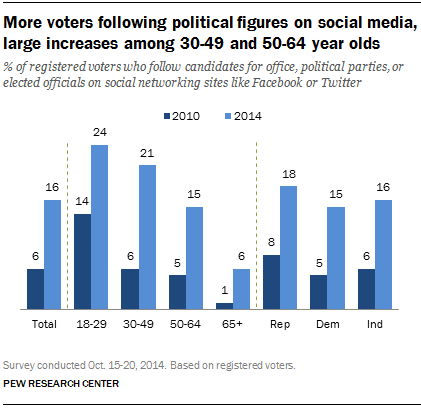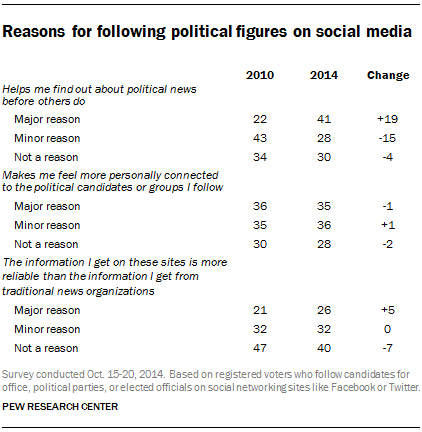Key Findings
Cell phones and social media platforms like Facebook and Twitter are playing an increasingly prominent role in how voters get political information and follow election news, according to a new national survey by the Pew Research Center.
The proportion of Americans who use their cell phones to track political news or campaign coverage has doubled compared with the most recent midterm election: 28% of registered voters have used their cell phone in this way during the 2014 campaign, up from 13% in 2010. Further, the number of Americans who follow candidates or other political figures on social media has also risen sharply: 16% of registered voters now do this, up from 6% in 2010.
Voters of all ages are more likely to take part in these behaviors than in the previous midterm race, but that growth has been especially pronounced among 30-49 year olds. Some 40% of voters ages 30-49 have used their cell phone to follow this year’s election campaign (up from 15% in 2010) and 21% follow political figures on social media (up from just 6% in 2010). Voters in this age group now take part in each of these behaviors at rates nearly identical to 18-29 year olds.
Participation in the digital campaign does not have a clear partisan slant. Republicans and Democrats engage in each of these behaviors at similar rates. At the same time, when asked about some reasons why they might follow political figures on social media, Republicans and Republican-leaning independents express a greater desire to be the first to find out about breaking political news, and to say that they use social media to get political information that has not passed through the traditional media “filter.” Voters from both parties place a similar emphasis on the deeper connections that social media allows them to form with the candidates they support.
Digital politics also goes hand in hand with other types of campaign engagement. In particular, the 16% of registered voters who follow political figures on social media participate in various traditional campaign activities at high rates—from volunteering and donating money, to encouraging others to get out and support their preferred candidates and causes.
This report is based on a national survey conducted October 15-20 among 2,003 adults (including 1,494 registered voters). Among the main findings:
One quarter of registered voters now get political news on their cell phones
As smartphone ownership has increased dramatically in recent years, more and more Americans are using their mobile devices to keep tabs on political events. Some 28% of registered voters have used their cell phone this year to keep up with news relating to the election or political events, which represents a two-fold increase compared with the most recent midterm election cycle. In a survey conducted at the end of the 2010 election campaign, just 13% of registered voters said that they had used their cell phones to keep up with election coverage.
 Registered voters of both parties are equally likely to use their phones to keep up with election news, as 25% of Republicans and 29% of Democrats report doing so this campaign season. And while voters of all ages are more likely to use their cell phones for political and election news than was the case during the 2010 midterms, this increase has been especially pronounced among voters in their 30s and 40s. Some 40% of registered voters ages 30-49 have used their cell phones to track election coverage this year, up from just 15% who did so during the previous midterm campaign.
Registered voters of both parties are equally likely to use their phones to keep up with election news, as 25% of Republicans and 29% of Democrats report doing so this campaign season. And while voters of all ages are more likely to use their cell phones for political and election news than was the case during the 2010 midterms, this increase has been especially pronounced among voters in their 30s and 40s. Some 40% of registered voters ages 30-49 have used their cell phones to track election coverage this year, up from just 15% who did so during the previous midterm campaign.
These “mobile election news consumers” are more active than other Americans when it comes to certain campaign activities, although in other ways they are similar to the voter pool as a whole. They are more likely to have encouraged people they know to vote or support a particular candidate (58% have done this, compared with 37% of registered voters who do not get campaign news on their cell phone) and to have attended a campaign event (11% vs. 6%). On the other hand, they are no more likely than other voters to make campaign contributions, or to volunteer their time to help a candidate or campaign.
More than twice as many Americans are following political candidates on social media as was the case during the 2010 midterms
A substantial majority of Americans use social networking sites like Facebook and Twitter, and 16% of registered voters now use these sites to follow candidates for office, political parties, or elected officials. This represents a more than two-fold increase from the previous midterm election in 2010, when just 6% of registered voters followed political candidates or groups on social media.1
 Supporters of both parties are equally likely to follow political figures on social media, with 18% of Republicans and 15% of Democrats doing so. And as was the case with mobile political activity, voters in their 30s and 40s have experienced a particularly substantial increase in this behavior. Some 21% of voters ages 30-49 follow political figures on social media, a more than three-fold increase from the previous midterm cycle.
Supporters of both parties are equally likely to follow political figures on social media, with 18% of Republicans and 15% of Democrats doing so. And as was the case with mobile political activity, voters in their 30s and 40s have experienced a particularly substantial increase in this behavior. Some 21% of voters ages 30-49 follow political figures on social media, a more than three-fold increase from the previous midterm cycle.
Americans who follow political figures on social media also tend to be highly engaged with various aspects of the election campaign. Among other things, they are more likely than voters who do not follow political figures via social media to volunteer their time to a candidate or campaign (11% vs. 4%); to make a campaign contribution (21% vs. 11%); to attend a campaign event (13% vs. 6%); and to encourage their friends to support a candidate or issue at the polls (62% vs. 39%). They are also more likely to say that they regularly follow government and public affairs, and to say that they have given quite a lot of thought to this year’s elections.
Increasing numbers of Americans are following political figures on social media in order to be first to hear about the political news of the day
 As political behavior on social media has grown more prevalent, the reasons voters give for following political figures in these spaces have also shifted somewhat compared with the previous midterm election. When presented with a list of reasons why they might choose to follow political candidates or groups on social media:
As political behavior on social media has grown more prevalent, the reasons voters give for following political figures in these spaces have also shifted somewhat compared with the previous midterm election. When presented with a list of reasons why they might choose to follow political candidates or groups on social media:
- 41% say that finding out about political news before other people do is a “major reason” why they follow political figures on social media. In 2010, just 22% said that this was a major reason.
- 35% say that feeling more personally connected to political candidates or groups is a “major reason” why they follow political figures on social media. This is unchanged from the 36% who cited this as a major factor in 2010.
- 26% say that getting more reliable information than what is available from traditional news organizations is a “major reason” why they follow political figures on social media. This is also statistically indistinguishable from the 21% who cited this as a major factor in 2010.
When it comes to political affiliation, Republican and Republican-leaning independents tend to place a greater emphasis on finding out about news quickly and on getting what they perceive as being more reliable information than is available from traditional news organizations. Some 50% of Republicans and Republican-leaning independents who follow political figures on social media say that getting news quickly is a “major reason” for doing so (compared with 35% of Democratic and Democratic-leaning independents), while 33% say that getting more reliable information than what is available from the traditional news media is a “major reason” (compared with 20% of Democrats). Republicans and Democrats are equally likely to say that feeling more personally connected to the candidates and groups that they support is a “major reason” for following those figures on social media.
Along with these shifts in the reasons people cite for following political figures on social media, there has also been a slight change in the way they think about the relevance of political content. Some 78% of Americans who follow political figures on social media say that the content posted by those figures is mostly interesting and relevant, while 20% say that the content is mostly uninteresting and not relevant to them. When we asked this question during the 2010 campaign, 67% said that this information was interesting and relevant, while 32% said that it was not interesting or relevant.


